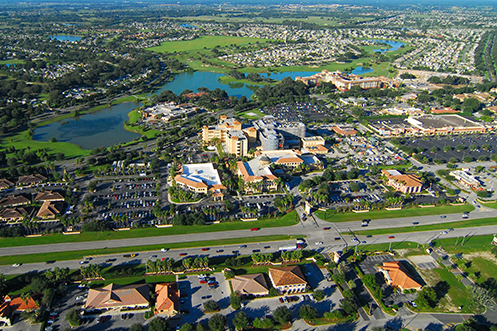Through the end of 2019, the United States Census Bureau population estimates show continuing growth for many southern states. This growth is mainly reflective of domestic migration, with a secondary factor of natural increase (higher number of births over deaths). Overall, the southern region of the nation saw both the largest numeric growth and percentage growth from 2018 to 2019.
The impact of the COVID-19 pandemic may result in some variations for 2020 and beyond. However, the same factors that are driving current population estimates are most likely to continue affecting future growth. This has broad implications for corporate growth initiatives and talent acquisition.
Population Estimates Show Southern Region Growing, Other Regions Declining
The Southern region of the U.S. is growing faster than the nation as a whole. Overall, the southern region accounts for over 65% of the nation’s population growth from 2018-2019.
| Region | Total Growth | Percentage Growth |
| United States | 1,552,022 | 0.5% |
| South | 1,011,015 | 0.8% |
By comparison, the Northeast Region saw population decline over the same period by 63,817, or -0.1%. The Northeast did experience a population gain of 97,152 due to natural increase over this time period, as well as an increase in net international migration of 134,145. However, net domestic migration out of the Northeast in the amount of 294,331 led to the overall population decline. The loss of nearly 300,000 residents from the Northeast is significant, and may be due to a variety of factors.
Cities and Suburbs
Many states in the Northeast feature comparatively small cities and towns. For example, the state of Connecticut’s largest city is Bridgeport, with a population of about 144,399. Georgia’s largest city is Atlanta, with a population of about 506,811. Regions losing population often face other difficulties such as a declining tax base and diminishing economic prosperity.
Adding suburbs to the city’s population estimates may shed further light. Greater Bridgeport has an estimated population of 305,000, while the entire Bridgeport-Stamford-Norwalk-Danbury metropolitan statistical area has a population of about 948,000 residents. Atlanta, on the other hand, has an urban population of 4.5 million residents. Also, the Atlanta metropolitan area has over 5.6 million residents. The largest city and metropolitan region in Connecticut does not compare favorably to the economic growth, size, and vitality of the largest city and metropolitan region in Georgia.
What do Population Estimates Show for the Southern Region?
Of the top 5 states in total numeric growth in population estimates from 2018-2019, four are in the South, and one is in the Southwest:
| Rank | State | Numeric Growth | % Growth |
| 1 | Texas | 367,215 | 1.3% |
| 2 | Florida | 233,420 | 1.1% |
| 3 | Arizona | 120,693 | 1.7% |
| 4 | North Carolina | 106,469 | 1.0% |
| 5 | Georgia | 106,292 | 1.0% |
Clearly the South continues its long period of population growth, while other regions of the U.S. lag. This pattern will result in many changes, from political representation to the ability to fund major infrastructure projects.
Why do People Continue Moving to the Southern Region of the U.S.?
There are several reasons why people decide to move to a new location. In terms of general population trends in the U.S., a few factors often top the list:
1. Jobs
Not surprisingly, all five of the top ranking states for growth in population estimates also rank in the top 20% of states for job growth from 2018-2019.
2. Cost of Living
Each of the top ranking states have cost of living that is lower than half of the other states in the nation. Georgia in particular ranks as the 9th least expensive state for cost of living.
3. Weather
People looking for beautiful weather will find it at each of the top ranking states. Factors that determine a state’s ranking for weather include comfortable temperatures, dry weather, and at least 60% annual sunshine.
What Do Population Estimates Mean for Employers?
Employers should review their future growth plans to determine if certain locations may be more amenable for expansion and talent acquisition. Many states have been investing significantly in education, a key component for state prosperity. The U.S. Census Bureau reports that spending per pupil increased for the sixth consecutive year nationwide. Taking into account variations in cost of living, spending per pupil appears to be somewhat comparable among many states and regions.
Conclusion
GMS’ team of domestic relocation experts has helped thousands of our clients develop hiring and recruiting programs that attract highly skilled job seekers to meet corporate growth objectives. As a result, our team can help your company understand the importance of population estimates for states as they relate to talent acquisition and your company’s ability to attract new hires and transferees.
GMS was the first relocation company to register as a .com. The company also created the first online interactive tools and calculators, and revolutionized the entire relocation industry. GMS continues to set the industry pace as the pioneer in innovation and technology solutions with its proprietary MyRelocation® technology platform.
Contact our experts online to learn more about population estimates as they relate to corporate growth and talent acquisition, or give us a call at 800.617.1904 or 480.922.0700 today.




